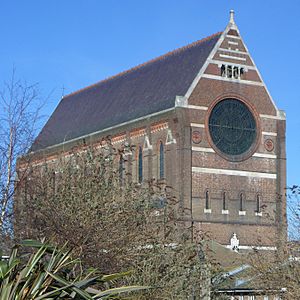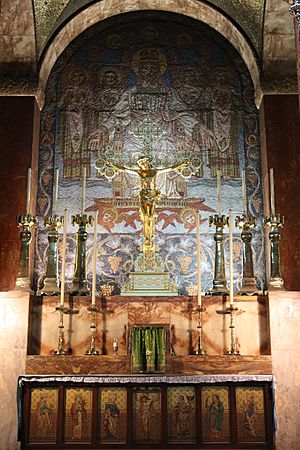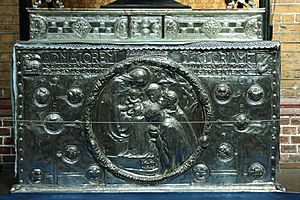St Bartholomew's Church, Brighton facts for kids
Quick facts for kids St Bartholomew's Church, Brighton |
|
|---|---|

The church from the south-southwest
|
|
| Denomination | Church of England |
| Churchmanship | Traditional Anglo-Catholic / Anglo-Papalist |
| History | |
| Dedication | St Bartholomew |
| Specifications | |
| Height | 144 ft (44 m) |
| Administration | |
| Parish | Brighton, St Bartholomew |
| Deanery | Brighton |
| Archdeaconry | Chichester |
| Diocese | Chichester |
| Province | Canterbury |
St Bartholomew's Church is a special Anglican church in Brighton, England. It's named after Saint Bartholomew, an apostle. This church is built in a style called neo-gothic, which means it looks like old churches from the Gothic period.
You can find it on Ann Street, between Brighton railway station and the A23 London Road. It's very tall and stands out in the area. You can see its unique red-brick walls from many parts of the city.
Contents
Building a Tall Church in Brighton
How St Bartholomew's Church Began
The idea for St Bartholomew's Church came from a vicar named Henry Michell Wagner. After he passed away in 1870, his son, Arthur Douglas Wagner, took over. Arthur wanted to build new churches in Brighton, just like his father had planned. St Bartholomew's was his own special project.
In 1868, Arthur Wagner first built a temporary church and a school. He wanted to build a much grander church in the same spot.
Plans for a Big Church
The first plan for the church was approved in 1871. It was going to be a church and school building combined. It was planned to be about 98 metres (322 feet) long and 14 metres (46 feet) wide.
But Arthur Wagner changed his mind. He decided he wanted a much taller church! In 1873, new plans were submitted. The church would be shorter, about 52 metres (170 feet) long, and wider, about 18 metres (59 feet). Most importantly, it would be incredibly tall, reaching about 41 metres (135 feet) to the roof. A cross on top adds another 2.7 metres (9 feet).
Building and Opening the Church
Building started in 1873 and took about 19 months. The church officially opened on September 18, 1874, even though work was still going on.
One special thing about St Bartholomew's was that it offered free seating for everyone. It could hold up to 1,500 people. This was the first church in Brighton to do this from the very beginning. Other churches used to charge people to sit in certain pews, which helped pay the clergy. So, not everyone was happy about the free seating!
Church Design and Features
Outside the Church: A Unique Look
A Brighton architect named Edmund Scott designed the church. Many people think Arthur Wagner had a lot of influence on the design, as he was willing to spend a lot of money to make it grand.
The outside of St Bartholomew's looks very unusual and strong. It's so tall that it stands high above the smaller buildings around it. This makes it look even more impressive.
The church is built with reddish-brown bricks. Over time, they have turned a purplish-brown color. The roof is very steep and covered with dark tiles. Along the sides, there are narrow supports called buttresses with tall, pointed windows.
On the south side, there's a huge round window called a rose window. At the very top of the roof, there's a 2.7-meter (9-foot) gilt (gold-covered) cross. This cross makes the church's total height about 44 metres (144 feet).
The building cost about £18,000 in 1874. This was less than other churches built around that time, partly because bricks were used instead of more expensive stone. The very northern part of the church was never fully finished. Also, ideas for extra parts like transepts (side wings) and a spire (a tall, pointed roof) were never built.
Inside the Church: Vast and Open
When you go inside, you'll notice how open and huge it feels. It's like one giant hall, with no big walls dividing it. This makes the church feel incredibly tall inside.
Along the side walls, there are tall arches. Underneath these arches are smaller side-chapels. Above these, near the roof, are more tall, pointed windows that let in light.
The inside walls are mostly made of the same brick as the outside. At the northern end, above the main altar, there's a large cross made of chalk, about 9 metres (30 feet) high. There are also carved wooden and stone pictures called Stations of the Cross on the side-chapel walls. These were brought from Bruges in 1881. Above the altar, you can see beautiful mosaics by F. Hamilton Jackson.
Decorating the Sanctuary
The main altar and the area around it, called the sanctuary, are very fancy. Many of these decorations were added after 1895 when a new vicar, Arthur W. C. Cocks, took over.
An architect and designer named Henry Wilson was in charge of this work. The sanctuary has a huge marble canopy, called a baldacchino, which is 13.7 metres (45 feet) tall. Underneath it is a new altar with a silver box called a tabernacle and a white marble shelf holding a large crucifix and candlesticks.
One of the side chapels has a special altar for the Virgin Mary. It was designed by Wilson in 1902 and is made of detailed silver on copper.
In 1906, Wilson also designed a new pulpit (where sermons are given) using different kinds of marble. It has red marble columns supporting a large block of green marble. A big organ gallery was also built at the south end of the church. It can hold the organ and up to 150 singers and musicians. In 1908, a large, eight-sided font made of green marble was added.
Henry Wilson stopped working on the church in 1911. Some plans for finishing the northern end of the church and other improvements were never completed, partly because of World War I.
Is it the Tallest Church?
Many people say St Bartholomew's is the "tallest church in England." This needs a bit of explaining! Many churches are taller if you include their spires or towers. For example, St Walburge's Church in Preston has a spire that reaches 94 metres (309 feet).
However, St Bartholomew's doesn't have a spire or a tower. Its height of 41 metres (135 feet) is the height to the very top of its roof. If you only count the main body of the church and not spires or towers, then the claim that it's one of the tallest churches makes more sense. It's also said to have the largest main open area (nave) of any parish church in Britain.
How People Reacted to the Church
Early Reactions and Controversy
When St Bartholomew's was first built, its unusual design and fancy inside caused a lot of talk. Some people didn't like it, especially those who were suspicious of the church's Anglo-Catholic style.
In 1874, someone wrote a letter to a local newspaper, the Brighton Herald. They worried about "dark spiral staircases" and "little and almost dark rooms" inside the church. They wondered if these were for nuns or hermits, and if the building was truly just a church. Actually, these were just parts of the church's upper walkways!
"Wagner's Folly" and Other Names
In 1893, there was a big discussion at the Town Council. It turned out the church was two feet taller than the plans had said! The fine for this was very small, so it wasn't a big deal for Arthur Wagner, who was wealthy.
But during this discussion, people used funny and sometimes mean names to describe the church. They called it "a cheese warehouse," "a Noah's Ark in brick," "a monster excrescence" (meaning a strange growth), "a brick parallelogram", "a huge barn," and "uselessly large, painfully ugly and sadly out of place." One popular nickname was "Wagner's folly." People still sometimes call it "Noah's Ark" because of its shape.
Some people who lived near the church also complained. They said the church's height caused strong winds that made their chimneys smoke too much. Arthur Wagner was rich enough to buy some of their houses and lower the rent for others, so they would stop complaining.
St Bartholomew's Today
St Bartholomew's Church is a Grade I-listed building. This means it's considered very important for its architecture and history in England.
Because it's so big and has great sound, it's a perfect place for concerts, especially classical music.
Images for kids
See also
- List of places of worship in Brighton and Hove
- List of Grade I listed buildings in Brighton and Hove












